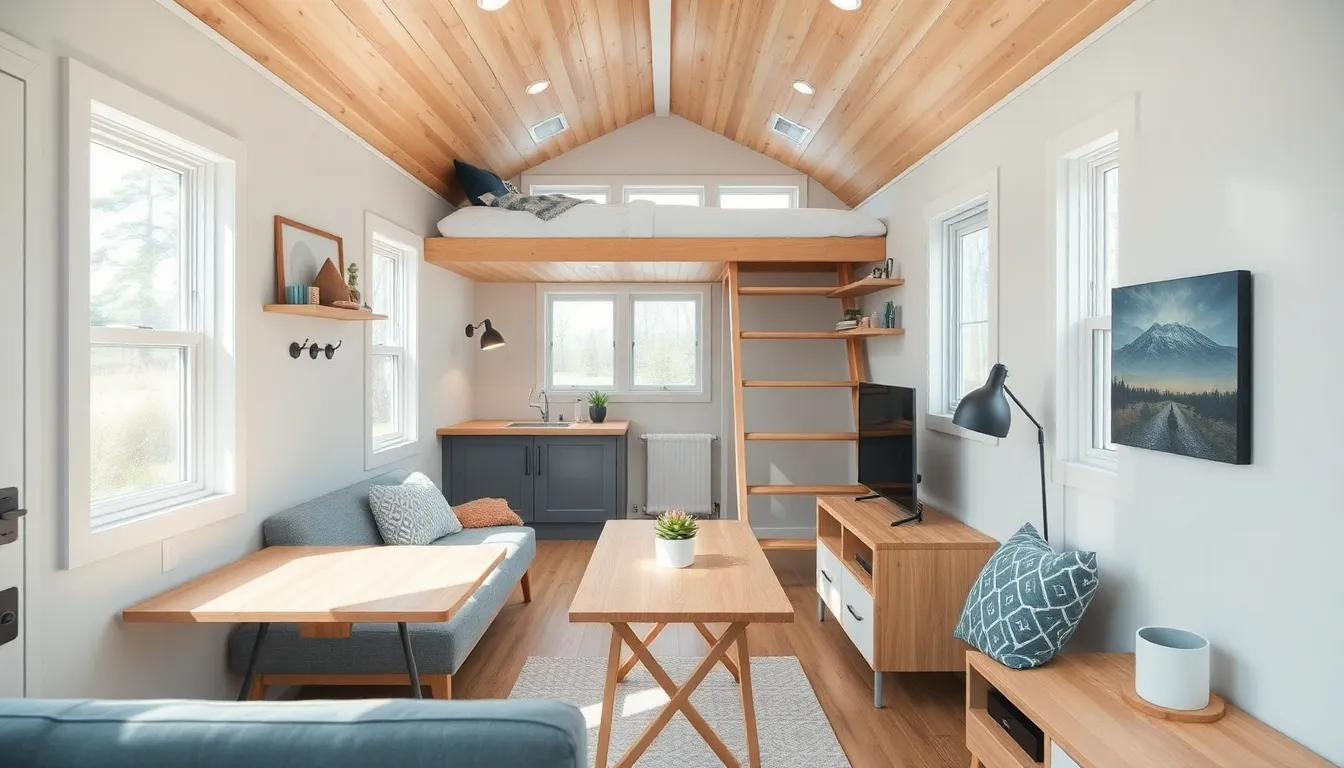Table of Contents
ToggleTiny house architecture is more than just a trend; it’s a movement that champions simplicity, sustainability, and creativity. As living spaces shrink and environmental concerns grow, these compact homes offer innovative solutions to modern housing challenges. They emphasize efficient design and multifunctional spaces, allowing individuals and families to live comfortably in smaller footprints.
With a focus on minimalism, tiny homes encourage a lifestyle that prioritizes experiences over possessions. This shift not only reduces the ecological impact but also fosters a sense of community among those who embrace this unique way of living. As the tiny house movement gains momentum, it inspires a new generation of architects and builders to rethink traditional concepts of home and space.
Overview of Tiny House Architecture
Tiny house architecture focuses on maximizing limited space through innovative design. Compact structures typically range from 100 to 400 square feet, promoting efficient use of materials and energy. Designers often incorporate sustainable practices to achieve eco-friendly homes that reflect a commitment to environmental stewardship.
Key features of tiny houses include:
- Multifunctional Spaces: Tiny houses utilize areas for multiple purposes, such as a dining area that converts into a workspace. This flexibility enhances the livability of small spaces.
- Larger Windows: Expansive windows increase natural light, creating an illusion of spaciousness while connecting the interior to the outside environment.
- Sustainable Materials: Architects often choose reclaimed wood, bamboo, or other eco-friendly materials, reducing the carbon footprint associated with traditional construction.
- Off-Grid Capabilities: Many tiny houses feature solar panels or rainwater harvesting systems, promoting a self-sufficient lifestyle without reliance on public utilities.
Tiny house architecture not only addresses practical housing needs but also encourages a shift toward a simpler, more mindful way of living. The design often reflects personal values and lifestyle choices, fostering a deeper connection to one’s surroundings.
Design Principles of Tiny Houses

Tiny house architecture centers on efficient use of space and simplicity in design. These principles contribute significantly to creating functional, sustainable living environments.
Space Efficiency
Space efficiency represents a core principle in tiny house design, where every square foot serves a purpose. Designers implement multifunctional furniture, such as foldable tables and beds with built-in storage, optimizing the available area. Vertical space often receives attention, incorporating lofted sleeping areas and shelving units that maximize storage without encroaching on living space. Open floor plans help create a sense of spaciousness by minimizing visual barriers. These strategies ensure that tiny houses can comfortably accommodate inhabitants while offering flexibility and practicality.
Minimalism in Design
Minimalism in design emphasizes simplicity, functionality, and a reduction in excess. Tiny houses utilize clean lines, neutral color palettes, and uncluttered spaces to promote serenity and focus. By prioritizing quality over quantity, homeowners invest in durable materials and essential items that enhance their lifestyle. This approach fosters mindfulness, encouraging individuals to reflect on their needs and desires, ultimately leading to more intentional living. Each element in a tiny house serves a distinct function, aligning with the overarching goal of enhancing the resident’s experience through reduced distractions and improved functionality.
Sustainability and Tiny Housing
Tiny housing emphasizes sustainable living and ecological responsibility through various strategies. The design principles and materials used in tiny houses significantly contribute to environmental sustainability.
Eco-Friendly Materials
Tiny houses often utilize eco-friendly materials, prioritizing renewable resources and sustainably sourced products. Common materials include bamboo flooring, reclaimed wood, and recycled metal. These options reduce the environmental impact compared to traditional building materials. Using non-toxic paints and finishes further enhances indoor air quality, promoting a healthier living environment. Additionally, many tiny homes incorporate insulation made from recycled products, increasing energy efficiency and comfort.
Energy Efficiency
Energy efficiency is paramount in tiny house architecture. Smaller living spaces require less energy for heating and cooling, leading to lower utility bills. Many tiny homes include energy-efficient appliances and fixtures, such as LED lighting, low-flow faucets, and energy-star-rated refrigerators. Moreover, solar panels and rainwater collection systems encourage off-grid living, allowing homeowners to generate clean energy and manage water resources. These systems not only minimize the ecological footprint but also foster self-sufficiency and sustainable lifestyles.
Popular Tiny House Styles
Tiny houses come in various styles, each reflecting unique architectural trends and personal preferences. The two popular styles are modern aesthetic and rustic charm, offering distinct design elements that cater to different lifestyles.
Modern Aesthetic
Modern tiny houses embrace clean lines, open spaces, and minimalist design. These structures often feature large windows that facilitate natural light and create an airy feeling. Materials like metal, glass, and concrete frequently dominate the exterior, fostering a contemporary look. Interior layouts prioritize functionality, showcasing multifunctional furniture that maximizes available space. Sleek cabinetry and neutral color palettes enhance the streamlined appearance while promoting a sense of calm.
Rustic Charm
Rustic tiny houses emphasize warmth and coziness through the use of natural materials. Wood predominates in both construction and interior design, often incorporating reclaimed and handmade elements for authenticity. Exposed beams and stone accents add character, creating an inviting atmosphere. These homes often include small porches or decks, blending the indoor and outdoor living experience. The decor typically features vintage furnishings and earthy tones, fostering a sense of comfort that resonates with traditional lifestyles.
Challenges in Tiny House Living
Tiny house living presents unique challenges that potential homeowners must navigate. Understanding zoning regulations and space limitations can significantly impact the feasibility and enjoyment of tiny homeownership.
Zoning and Regulations
Zoning laws often dictate where tiny houses can be placed and used as residences. Many areas classify tiny houses as recreational vehicles, imposing restrictions that limit their installation on permanent foundations. Homeowners may encounter challenges related to minimum size requirements for residential structures, which can prevent tiny houses from being legally recognized. Some municipalities offer specific guidelines for tiny homes, while others lack clear regulations, leading to confusion. Compliance with local building codes is essential for safety and legality, and obtaining necessary permits can be a lengthy process.
Space Limitations
Space limitations significantly influence tiny house living. With typical sizes ranging from 100 to 400 square feet, maximizing every square foot becomes crucial. Limited storage options can pose significant challenges for homeowners accustomed to larger spaces. Organizing and decluttering regularly is necessary to maintain a functional living environment. Additionally, accommodating essential amenities like kitchens and bathrooms requires innovative design solutions that may not suit everyone’s preferences. Adapting to a smaller footprint can also affect social dynamics, as hosting gatherings or having overnight guests may require creative solutions.
Tiny house architecture represents a transformative approach to living that prioritizes efficiency and sustainability. By embracing innovative design and multifunctional spaces, it not only addresses modern housing challenges but also promotes a lifestyle centered on minimalism and ecological responsibility.
As the movement gains momentum, it continues to inspire both architects and homeowners to rethink traditional concepts of space and community. The unique styles and sustainable practices inherent in tiny houses reflect a growing desire for a more intentional way of life.
Ultimately, tiny house living fosters a deeper connection to the environment while encouraging individuals to focus on what truly matters, paving the way for a more mindful and fulfilling existence.







